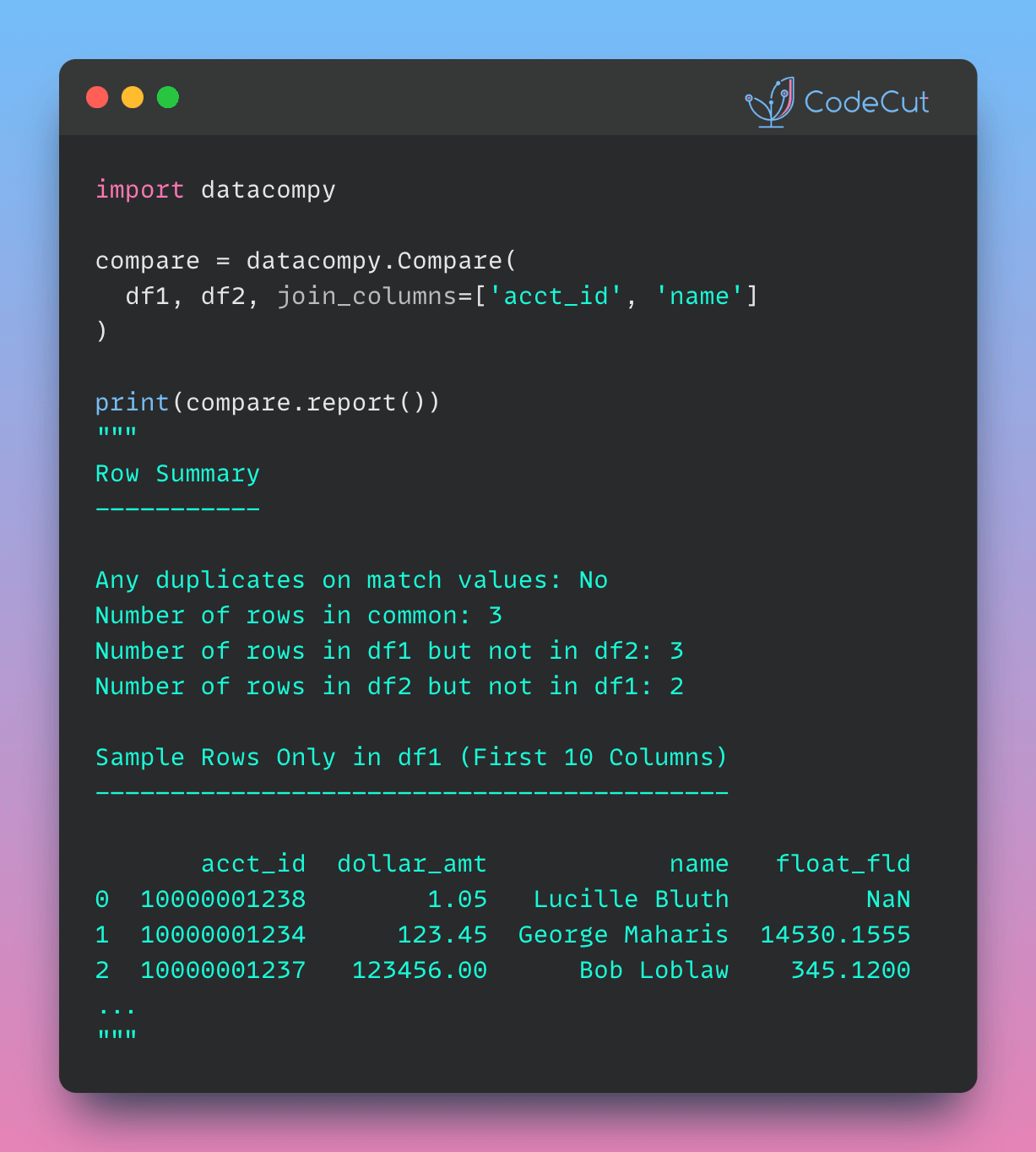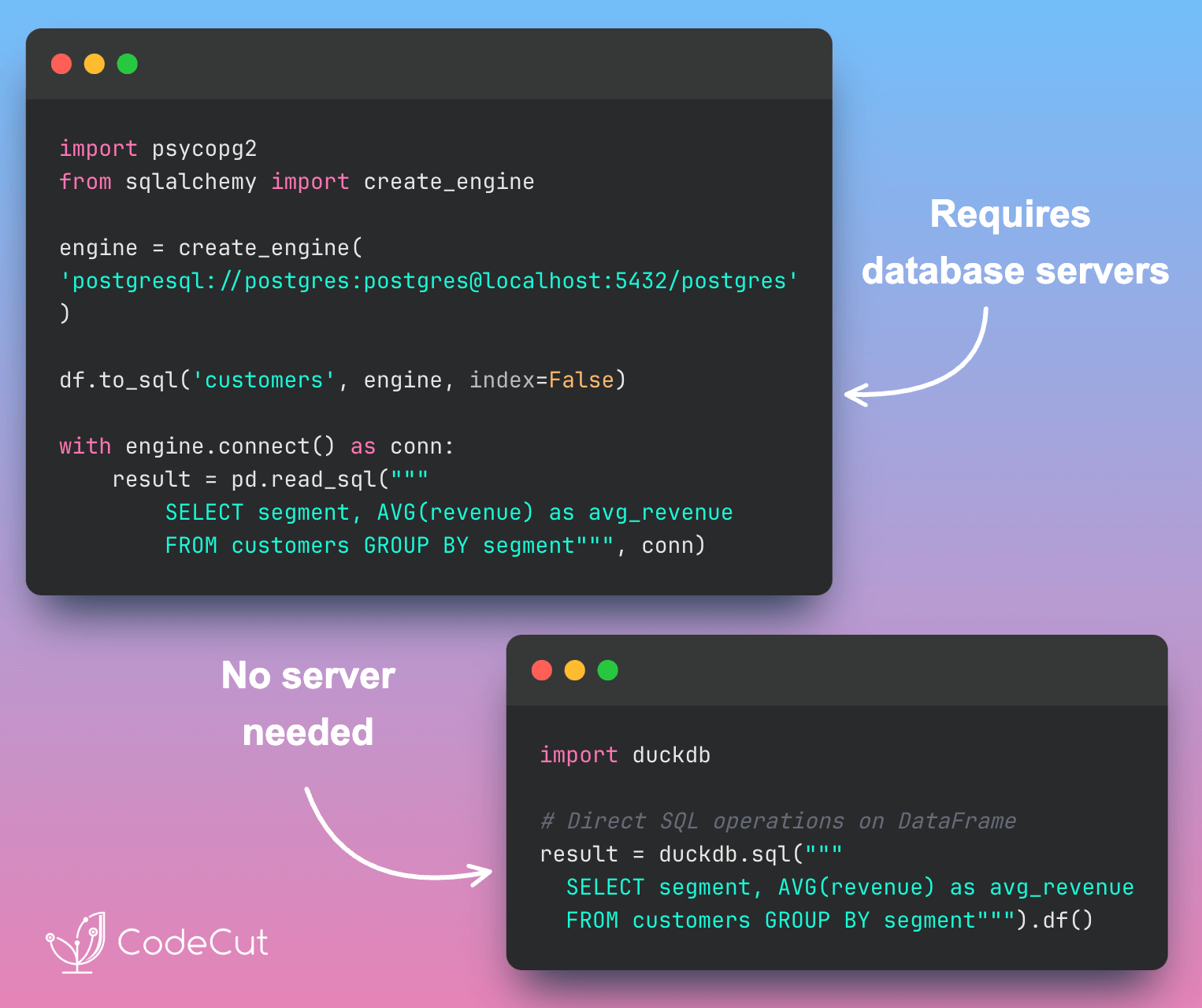The Problem with Manual Comparison
Comparing two datasets is a common task in data analysis and engineering, particularly when validating data transformation logic, quality checks, or migration processes.
Without a dedicated library, comparing datasets often involves writing complex code to compare values, identify mismatches, and generate comparison reports. This approach is time-consuming and prone to errors.
Let’s consider two sample datasets, df1 and df2, in the form of Pandas DataFrames.
import pandas as pd
data1 = """acct_id,dollar_amt,name,float_fld,date_fld
10000001234,123.45,George Maharis,14530.1555,2017-01-01
10000001235,0.45,Michael Bluth,1,2017-01-01
10000001236,1345,George Bluth,,2017-01-01
10000001237,123456,Bob Loblaw,345.12,2017-01-01
10000001238,1.05,Lucille Bluth,,2017-01-01
10000001238,1.05,Loose Seal Bluth,,2017-01-01
"""
df1 = pd.read_csv(StringIO(data1))
data2 = """acct_id,dollar_amt,name,float_fld
10000001234,123.4,George Michael Bluth,14530.155
10000001235,0.45,Michael Bluth,
10000001236,1345,George Bluth,1
10000001237,123456,Robert Loblaw,345.12
10000001238,1.05,Loose Seal Bluth,111
"""
df2 = pd.read_csv(StringIO(data2))Comparing these datasets manually requires complex code:
# Check if shapes match
shape_match = df1.shape == df2.shape
# Compare values
merged = df1.merge(df2, on=['acct_id', 'name'], how='outer', suffixes=('_1', '_2'))
mismatches = merged[merged['dollar_amt_1'] != merged['dollar_amt_2']]
missing = merged[merged['dollar_amt_1'].isna() | merged['dollar_amt_2'].isna()]
# Manual reporting
print(f"Shapes match: {shape_match}")
print("\nMismatches:")
print(mismatches)
print("\nMissing records:")
print(missing)Outputs:
Shapes match: False
Mismatches:
acct_id dollar_amt_1 name float_fld_1 date_fld \
0 10000001234 123.45 George Maharis 14530.1555 2017-01-01
3 10000001237 123456.00 Bob Loblaw 345.1200 2017-01-01
4 10000001238 1.05 Lucille Bluth NaN 2017-01-01
6 10000001234 NaN George Michael Bluth NaN NaN
7 10000001237 NaN Robert Loblaw NaN NaN
dollar_amt_2 float_fld_2
0 NaN NaN
3 NaN NaN
4 NaN NaN
6 123.4 14530.155
7 123456.0 345.120
Missing records:
acct_id dollar_amt_1 name float_fld_1 date_fld \
0 10000001234 123.45 George Maharis 14530.1555 2017-01-01
3 10000001237 123456.00 Bob Loblaw 345.1200 2017-01-01
4 10000001238 1.05 Lucille Bluth NaN 2017-01-01
6 10000001234 NaN George Michael Bluth NaN NaN
7 10000001237 NaN Robert Loblaw NaN NaN
dollar_amt_2 float_fld_2
0 NaN NaN
3 NaN NaN
4 NaN NaN
6 123.4 14530.155
7 123456.0 345.120
Introducing Datacompy
Datacompy is a Python library that simplifies dataset comparison by providing a single interface for joining, comparison logic, and reporting. It supports various data frameworks, including Pandas, Spark, Polars, and Snowflake.
To compare two datasets, we create a Compare object and pass in the two DataFrames, along with the join columns.
import datacompy
compare = datacompy.Compare(df1, df2, join_columns=['acct_id', 'name'])To generate a detailed comparison report, we can call the report() method on the Compare object.
print(compare.report())Output:
DataComPy Comparison
--------------------
DataFrame Summary
-----------------
DataFrame Columns Rows
0 df1 5 6
1 df2 4 5
Column Summary
--------------
Number of columns in common: 4
Number of columns in df1 but not in df2: 1 ['date_fld']
Number of columns in df2 but not in df1: 0 []
Row Summary
-----------
Matched on: acct_id, name
Any duplicates on match values: No
Absolute Tolerance: 0
Relative Tolerance: 0
Number of rows in common: 3
Number of rows in df1 but not in df2: 3
Number of rows in df2 but not in df1: 2
Number of rows with some compared columns unequal: 3
Number of rows with all compared columns equal: 0
Column Comparison
-----------------
Number of columns compared with some values unequal: 1
Number of columns compared with all values equal: 3
Total number of values which compare unequal: 3
Columns with Unequal Values or Types
------------------------------------
Column df1 dtype df2 dtype # Unequal Max Diff # Null Diff
0 float_fld float64 float64 3 NaN 3
Sample Rows with Unequal Values
-------------------------------
acct_id name float_fld (df1) float_fld (df2)
0 10000001236 George Bluth NaN 1.0
1 10000001238 Loose Seal Bluth NaN 111.0
2 10000001235 Michael Bluth 1.0 NaN
Sample Rows Only in df1 (First 10 Columns)
------------------------------------------
acct_id dollar_amt name float_fld date_fld
0 10000001238 1.05 Lucille Bluth NaN 2017-01-01
1 10000001234 123.45 George Maharis 14530.1555 2017-01-01
2 10000001237 123456.00 Bob Loblaw 345.1200 2017-01-01
Sample Rows Only in df2 (First 10 Columns)
------------------------------------------
acct_id dollar_amt name float_fld
0 10000001237 123456.0 Robert Loblaw 345.120
1 10000001234 123.4 George Michael Bluth 14530.155By using Datacompy, you can simplify your dataset comparison workflow and focus on more important tasks.





